Ner-a-Car 1924
As real boffin I have a strong preference for motorcycles where unusual technical constructions have been applied. In other words: motorcycles that differ from the "average" motorcycle. One of the most unusual bikes that has commercially been reasonably succesfull is the Ner-a-Car. It has:
- a flat chassis made of pressed steel beams, like a car, instead of a normal motorcycle frame from steel tubes
- hub-centered steering instead of the normal pivotting front forks
- a variable transmission using a friction wheel, mounted perpendicular on the engines flywheel, instead of a normal gearbox
- amply sized sheet metal shielding around the wheels and the drive unit, to keep the driver clean from oil and road dirt
The Ner-a-Car has been designed by an American named Carl Neracher. The name of the bike is a pun, based on his name and the fact that it is "near a car". It was said that the bike drives as easy as a car and that, in contradiction to other motorbikes, the driver does not get dirty. On the other hand it was (in comparison to a car) cheap, light and easy to manouvre and store, just like a motorbike. In other words: the best of both worlds! Obviously Carl Neracher lived in a place where rain is exceptionaly....
Although the design of the Ner-a-Car had already been made and heavily patented in the late 1910's, building started not earlier than 1921. The factory was based in Syracuse, state of New York. Production ended in 1927.
Neracher had given a license to Simplex-Sheffield in England, to build Ner-a-Cars for the UK and Commonwealth. There are some differences between the US and UK versions (see further on), and although both are not really pretty bikes, the USA version is to my opinion the nicest of them.
Despite the unusual construction and appearance, the Ner-a-Car was a commercial success. In total 16.500 bikes were built, of which 10.000 in the USA and 6.500 in the UK.
Because of the strange technical solutions I always wanted to have a Ner-a-Car. In 2023 I was lucky, as a friend offered me his 2nd Ner-a-Car. He had one in original condition, and build 2 others from a large pile of parts, completed with a lot of loose parts gathered from different sources like eBay. Soon after building he sold one of the compiled bikes to make room for another motorcycle, and after a few years he wanted to sell the other one to me. All 3 were the USA type.
Now, let's see how it looks. Here a few pictures of the bike in the condition that I bought it, still a bit dirty from the use since it had been completed:

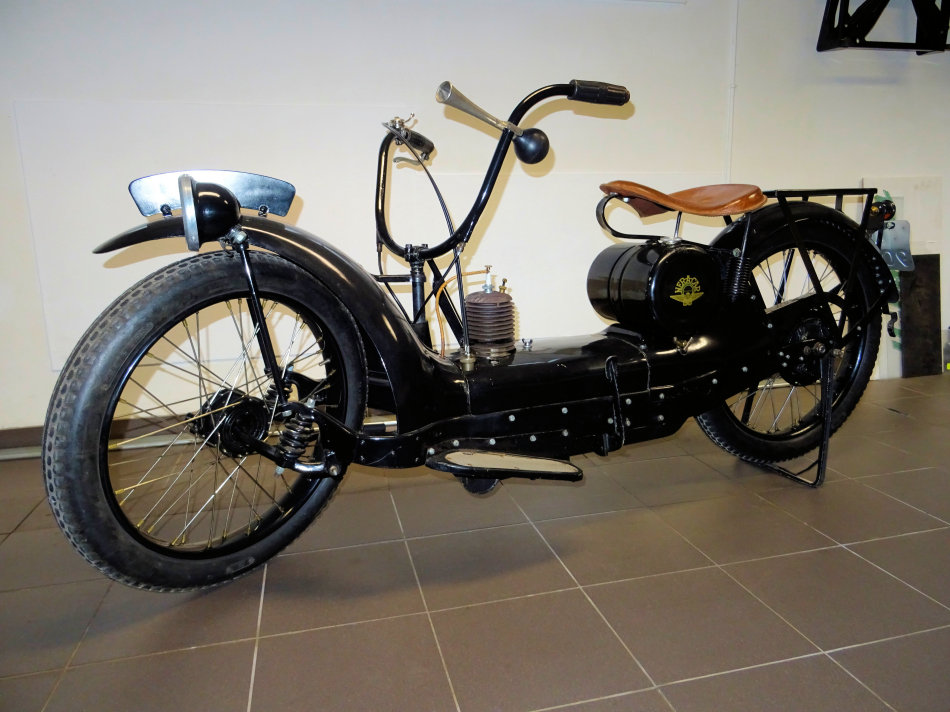
Here 2 pictures made by professional photographer Henny B. Stern, after a good cleaning of my Ner-a-Car. The second photo shows how wide the front mudguard is. Remarkable detail are the 2 headlights, giving the impression that the bike is looking at you with its eyes.


Let's have a closer look to see technical details of the Ner-a-Car. First the hub-centered steering system:
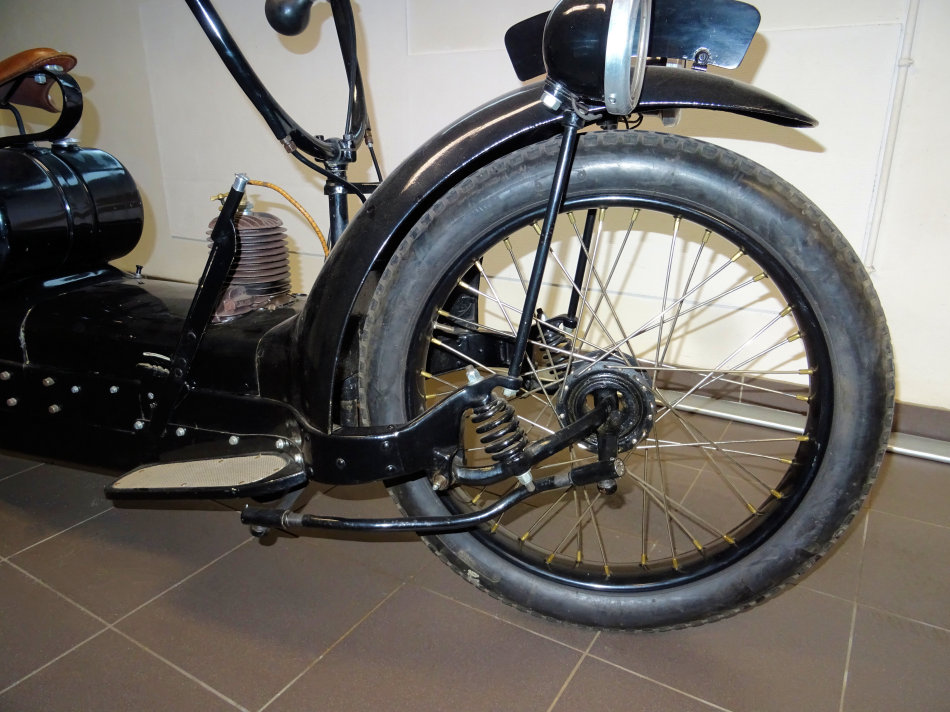
The lower rod is linking the handlebars with the steering lever on the hub by means of 2 ball joints. As the arm on the handlebars shaft is longer than the arm on the hub side, a small rotation of the handlebars gives a larger rotation of the wheel. This makes that moving the Ner-a-Car by hand feels very strange, as the bike always makes a sharper turn than you expect.... When driving this effect does not give a problem, as you can feel very well what the bike is doing when you start making a turn.
Here a detail of the hub, with the pivotting point in the center:

Here 2 drawings from the patent that describes the construction of the chassis and steering mechanism (US1.547.157, filed June 1921) which elucidate the front wheel construction:

This picture that I found on internet shows the front wheel bearing (as in the patent, I have also seen a picture of a unit bearing so there might be different versions):
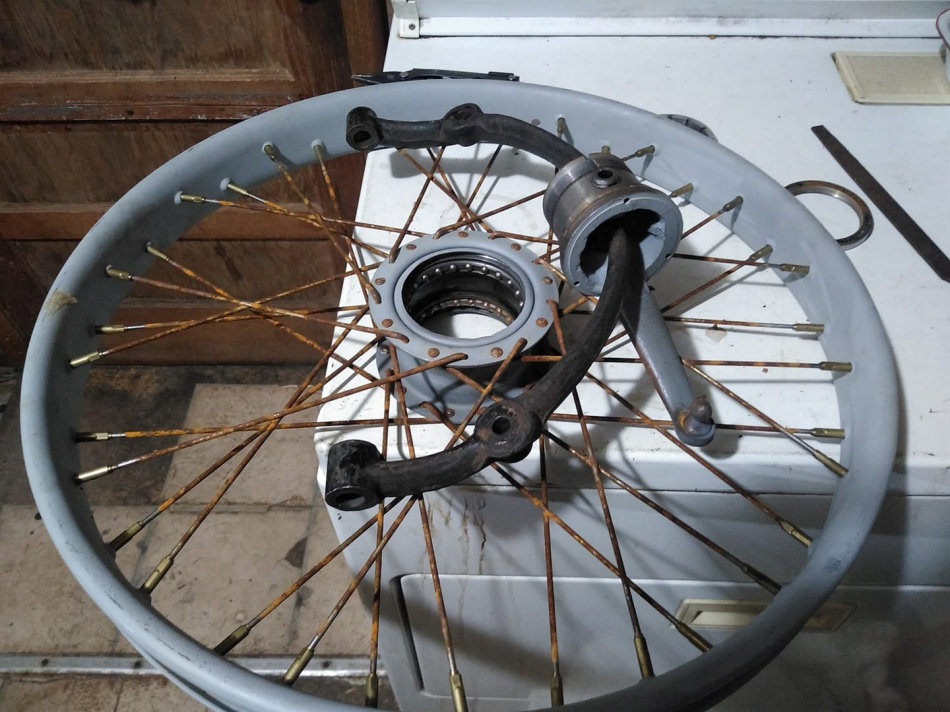
As you can clearly see in the patent drawing, the pivotting axis is backwards inclined, just like the steering head of a normal (motor)bike. This makes that the bike has a trail (the point of intersection from the line through the pivot axis and the ground lies in front of the point where the wheel touches the ground) which causes the self-centering effect of the front wheel, required for stable straight running.
In combination with the long wheel base and the low centre of gravity this makes that the Ner-a-Car is such a good straight runner. This, and the claim that the bike couldn't skid, was even used as a sales argument. For promotional purposes pictures were used of people riding the Ner-a-Car with no hands on the handlebars, or even lying or standing on the seat. Here a few examples:

UK version of the Ner-a-Car, riding in high gear (visible on the position of the gear lever)

USA version of the Ner-a-Car in the Netherlands
If you look closely to the last picture, you can see that the driver even has her eyes closed, so confident she was in the running of the bike! But this is not just an average woman.....
The lady on the bike is Miss Gwenda Janson, born Glubb and later named Stewart and Hawkes, a very experienced motorcyclist. She raced on different motorcycles, later in cars, and broke a few speed records. One was the famous Brooklands Double-12-hour (a 24 hour endurance race, but split in 2 parts of 12 hours each to avoid riding at night) in 1922 on a Trump motorcycle (really Trump, no typing error!). Another one, very interesting in this case, was a 1000 mile record in 1921 riding on a Ner-a-Car! (Sources: Wikipedia, Rideapart.com)
The engine was an own design of Ner-a-Car. It was a single cylinder 2-stroke, originally 222cc. Later the engine was in the USA enlarged to 255cc, but in the UK replaced by a 285cc Simplex 2-stroke engine. Still later the UK version was also available with a Blackburn 4-stroke engine with conventional gearbox instead of the friction drive.
Here a picture of the motor in my bike, which is the 255cc USA version (easily recognisable by the vertical cooling fins on the head, the 222cc has horizontal fins from top to bottom):

I will try to explain how the friction drive works. It is using a wheel with a special high-friction material, which is mounted perpendicular to the flywheel of the engine. You can press the friction wheel against the flywheel by turning the grip on the left side of the handlebars, giving the effect of engaging a normal clutch.
The friction wheel can slide sideways over its shaft (with splines), changing the point where it touches the flywheel, by moving the long handle on the right side of the bike. You start riding with the friction wheel close to the center of the flywheel, giving a low gear effect. When you have a certain speed, you shift the friction wheel more to the outer edge of the flywheel, giving the effect of changing to a higher gear. Although the position of the friction wheel can theoretically be varied continuously, the handle can be locked in 5 positions.
Here a picture showing the drive:

As you can see, the engine is placed with the crankshaft in longitudinal direction of the bike.
On the picture the friction wheel is in the outer position, thus the "highest gear" position. There is some space visible between the friction wheel and the flywheel, meaning the "clutch" is disengaged. The small cog with the spring in the middle of the flywheel is the ratchet mechanism of the kickstarter, which is just visible on the lower left of the picture.
Here another picture of the friction drive, found on internet. Here the bottom pan is removed, normally the underside is completely closed. Again, the friction wheel is in the outer "high gear" position.
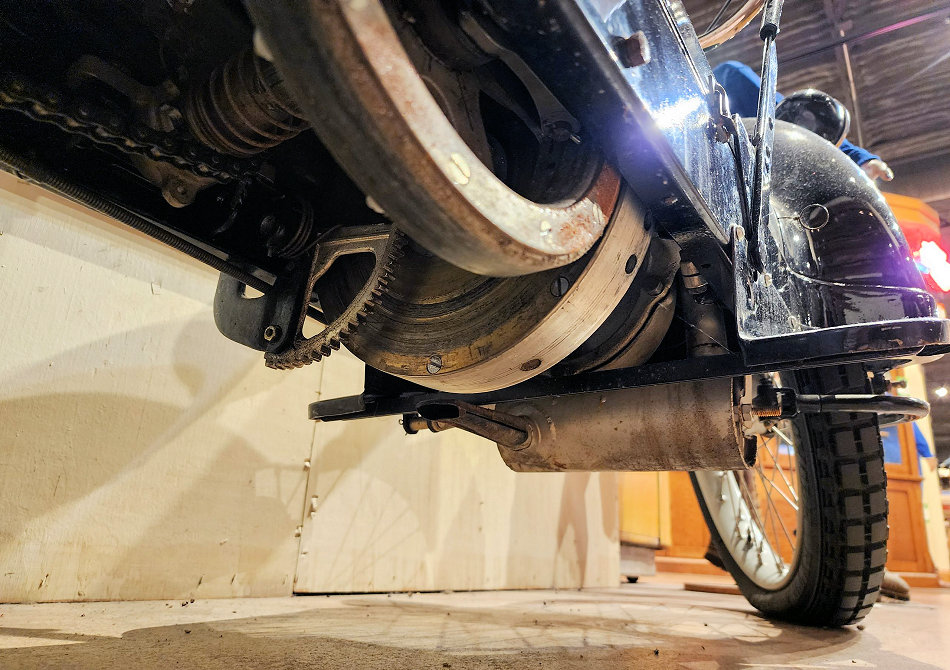
The toothed quadrant is connected to the kickstarter pedal. The chain drive to the rear wheel is also visible, the front sprocket is mounted on the shaft of the friction wheel.
Here the "gear lever" to shift the friction wheel:

Most remarkably for me was the material of the friction wheel. It is consisting of an aluminum core (not surprising) with an outer ring of laminated paper! This is generally called a "paper pulley".
Although it sounds like a very weak thing, it seems to be able to transmit quite high forces. This kind of friction drives was often used to drive flat belts on old tractors, stationary engines and steam machines, but also in some earth-moving machines (e.g. Caterpillar D2) and antique cars.
At the moment there seems to be only 1 company
left that makes this kind of pulleys (paperpulleys.com), the friction wheel of my bike also comes from them. As alternative it seems possible to use Masonite, a special extra hard kind of hardboard, but I have not yet heard or read from someone who has tried this on a Ner-a-Car.
Let's have a look at the reconstruction of my Ner-a-Car (as said, not done by myself). First picture shows the pile of loose parts which was the start of the project:
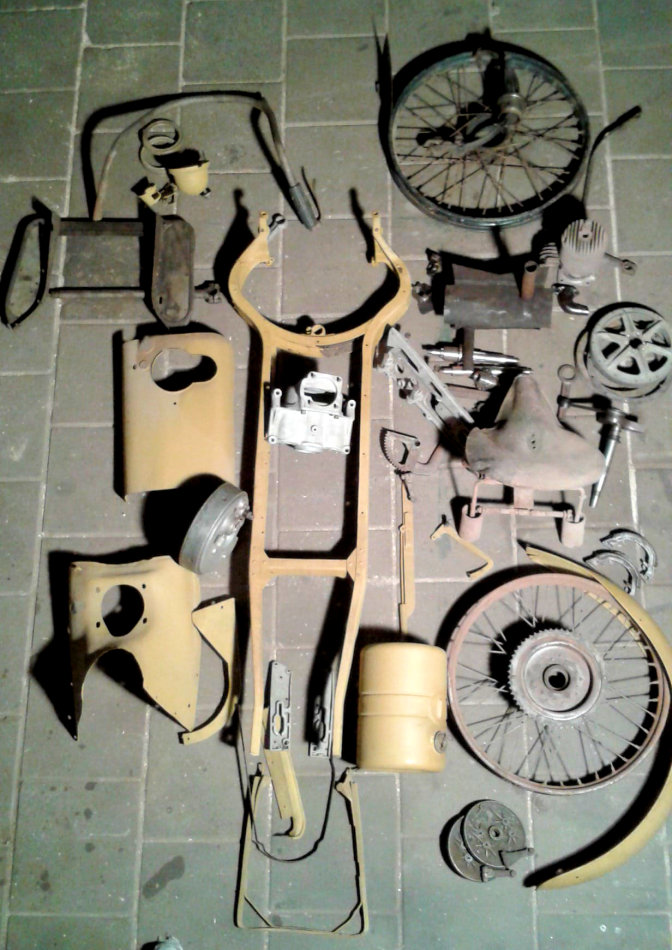
After a lot of work, the rolling chassis could be built. The next picture of the 2 Ner-a-Cars under construction gives a good idea how they are built underneath all the bodywork:

Due to the construction of the front hub it was almost impossible to make a front brake on the bike. To compensate for this, the first version had, next to the usual drum brake in the rear wheel, a 2nd brake that worked on the shaft of the friction wheel and the chain sprocket. Later versions had 2 drum brakes in the rear wheel, one on each side:

The left brake is operated with a pedal on the left footboard, the right one by hand on the right side of the handlebars.
The engine and drive shaft are mounted on aluminium mounts, that are bolted on the inside of the chassis beams:
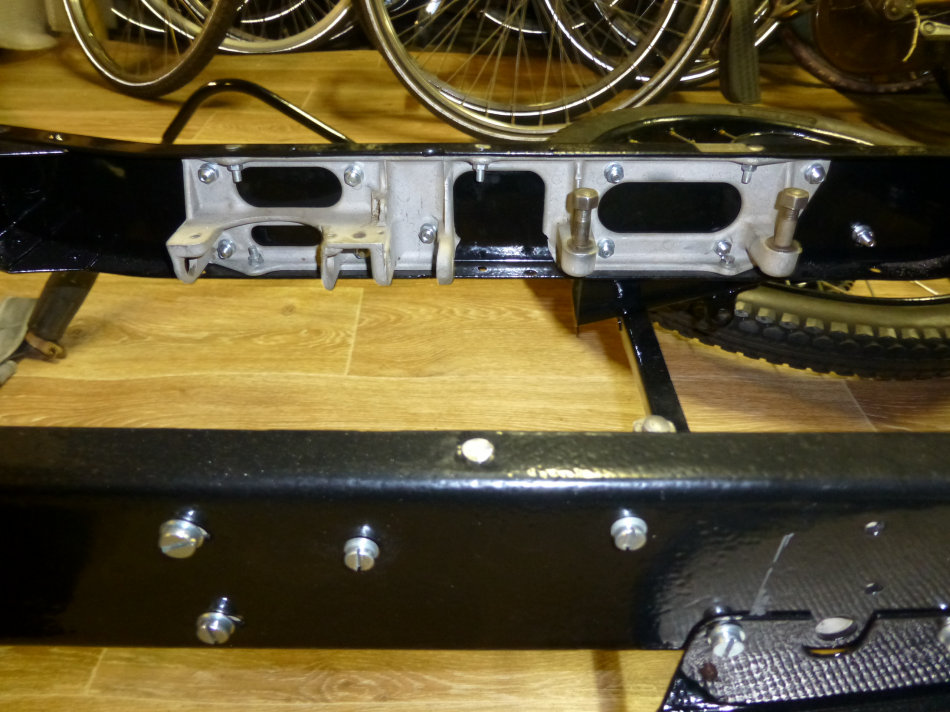
And finally the result, the 2 almost finished Ner-a-Cars next to each other, with mine on the left:

If you want to see more details of the construction of the Ner-a-Car, have a look at the following websites:
- Bodgesoc's blog
This blog gives an extensive description of the restauration of a UK Ner-a-Car that was in really bad condition. The whole process of reconstruction of the chassis and a lot of other parts is very well described and illustrated with pictures.
- Ben Geutskens Ner-a-Car site
On this website there is an enormous amount of information on the English Ner-a-Car. This includes a lot of drawings and pictures showing the individual parts with their dimensons. A very valuable source of information for everybody who is restoring a UK Ner-a-Car!
Although the USA and UK version at first glance look very similar, almost no parts are 100% the same. This just became clear to me when I compared the pictures on the 2 websites mentioned above with my own bike.
The most visible differences are (as far as I know at the moment):
- The front suspension: USA version has only compression springs, mounted backwards inclined, while UK version has vertical springs and small recoil springs underneath the chassis beam
- Wheel base: UK version looks longer than USA version, after checking it appeared that it has a longer wheelbase (150 vs. 141 cm)
- Steering linkage: USA version has the linkage more or less straight between the 2 connection points, the UK version has a 180° bend on the front
- Front mudguard: UK version is wider and has a bit longer sides than the USA version (from 1923 on, first version was same as USA)
- Headlights: USA version has, depending on the year, a single electric lamp on the front mudguard or 2 electric lamps next to the mudguard, UK version has an electric lamp on the right side and an acetylene lamp on the left
- Handlebars: USA version is more upright and higher than the UK version
- Engine (UK 2-stroke version only): USA version is own Ner-a-Car design and has the carburettor connection on the left side of the cylinder and exhaust on the right, while the UK version is a Simplex engine that has the carburettor right and exhaust left; in fact the cylinder of the UK version looks to be turned 180° compared to the US version
- Ignition: USA version has an Eisemann ignition, UK unbranded and with different coils and magnets inside
- Fuel tank: USA version has the filler cap and fuel tap on the left side, UK version has them in the middle of the tank; with the UK version the seat must be lifted to come to the filler cap
Later UK Ner-a-Cars with 4-stroke engines had a wider tank, with on the left side a separate compartment for oil
and the fuel in the right side
- Luggage rack is completely different
Here some pictures of the USA and UK versions, taken under more or less the same conditions for good comparison (source: archive www.yesterdays.nl):

USA version, 1924

UK version, 1922
On the pictures you can see that the UK version looks longer than the USA version. Because it was not clear to me whether this is real or just a visual impression due to other differences (the lower seat and handlebars of the UK version), I checked information of a few Ner-a-Cars that I know at the website of the Rijksdienst voor het Wegverkeer (RDW), the Dutch authority for vehicle licensing. According to their data the wheel base of the USA version is 141 cm, and of the UK version 150 cm. Although a small difference, it matches with the visual impression.

USA version, 1924

UK version, 1922
And finally a later UK version with the larger front mudguard, but with different lighting:

UK version, 1924
Finally, a nice historical picture of Carl Neracher himself, sitting on one of his motorcycles (found on the website of The Vintagent):

|

